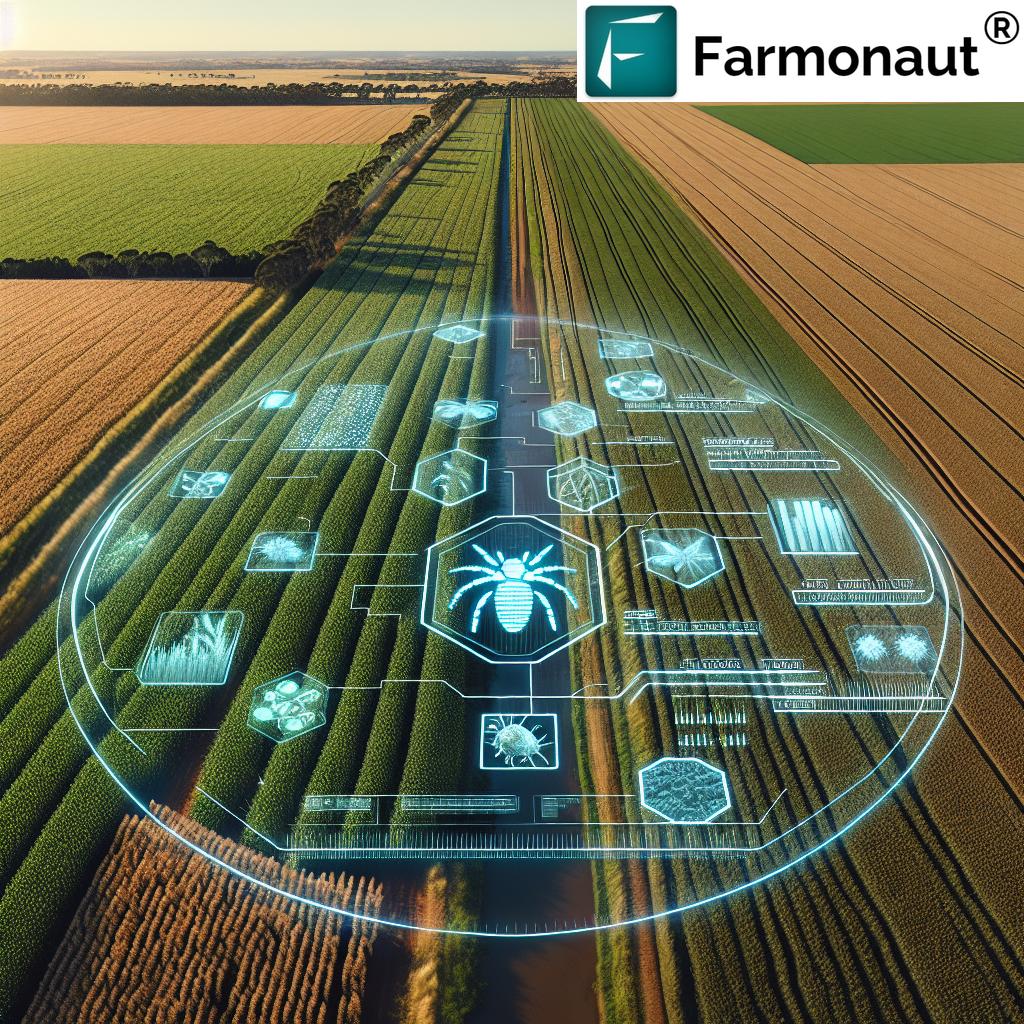Boosting Australian Grain Biosecurity: Critical Measures and Innovations for Sustainable Farm Management
“Australian grain biosecurity threats cost growers billions annually, prompting increased government funding and airport measures.”
In the ever-evolving landscape of Australian agriculture, we find ourselves at a critical juncture where the importance of grain biosecurity and sustainable farm management cannot be overstated. As industry experts and agricultural technology pioneers, we at Farmonaut recognize the urgent need to address the escalating threats to our nation’s grain production. The latest National Biosecurity Update has shed light on the pressing concerns that are costing our growers billions each year, emphasizing the need for innovative solutions and heightened vigilance.
In this comprehensive exploration of Australian grain biosecurity, we’ll delve into the current state of affairs, examine the critical measures being implemented, and highlight the innovations that are shaping the future of sustainable farm management. Our focus will be on providing you, the stakeholders of the Australian grain industry, with actionable insights and a clear understanding of the challenges and opportunities that lie ahead.
The Current State of Australian Grain Biosecurity
The Australian grain industry stands as a cornerstone of our national economy, contributing significantly to both domestic food security and export earnings. However, the sector faces unprecedented challenges in the form of evolving pest and disease threats. These biosecurity risks not only jeopardize crop yields but also have far-reaching implications for the entire agricultural value chain.
- Escalating threat landscape
- Billions in annual losses
- Increased government focus and funding
- Enhanced airport biosecurity measures
The gravity of the situation is underscored by the government’s proactive stance, which includes ramping up biosecurity measures at airports and allocating increased funding to bolster our national biosecurity capabilities. This renewed focus is a clear indication of the critical nature of the challenges we face and the collective resolve to address them head-on.

Critical Measures for Enhancing Grain Biosecurity
In response to these challenges, a multi-faceted approach is being adopted to strengthen our biosecurity framework. Let’s explore some of the key measures that are being implemented:
1. Development of the National Pest Action Plan
At the forefront of our biosecurity efforts is the development of a comprehensive National Pest Action Plan. This strategic initiative places a particular emphasis on combating the khapra beetle, a formidable threat to stored grains. The plan encompasses:
- Early detection protocols
- Rapid response mechanisms
- Integrated pest management strategies
- Collaborative efforts between government agencies and industry stakeholders
By focusing on this specific pest, the action plan serves as a model for addressing other potential biosecurity threats, showcasing the industry’s commitment to proactive crop disease prevention and sustainable farming practices.
2. Enhanced Border Control and Surveillance
Recognizing that prevention is key to effective biosecurity, significant resources are being allocated to strengthen our border control and surveillance capabilities. This includes:
- Advanced screening technologies at ports and airports
- Increased staffing of biosecurity officers
- Improved data analytics for risk assessment
- Collaboration with international partners to share intelligence on emerging threats
These measures aim to create a robust first line of defense against the introduction of new pests and diseases that could devastate our grain industry.
3. Industry Engagement and Education
A crucial aspect of our biosecurity strategy involves engaging and educating stakeholders across the grain industry value chain. This includes:
- Regular workshops and training sessions for farmers and agronomists
- Development of best practice guidelines for on-farm biosecurity
- Creation of awareness campaigns to highlight the importance of individual actions in maintaining biosecurity
- Establishment of networks for rapid information dissemination in case of biosecurity incidents
By fostering a culture of biosecurity awareness, we aim to ensure that every participant in the grain industry becomes an active guardian of our collective biosecurity.
Innovations Driving Sustainable Farm Management
While robust biosecurity measures form the foundation of our defense against pests and diseases, the integration of innovative technologies is revolutionizing how we approach sustainable farm management. At Farmonaut, we’re at the forefront of this technological revolution, offering cutting-edge solutions that empower growers to make informed decisions and optimize their operations.
1. Satellite-Based Crop Monitoring
Our advanced satellite imagery technology provides real-time insights into crop health, enabling early detection of potential issues. This technology allows growers to:
- Monitor vegetation health through NDVI (Normalized Difference Vegetation Index) analysis
- Assess soil moisture levels across vast areas
- Identify areas of stress or potential disease outbreaks before they become visible to the naked eye
By leveraging these insights, farmers can implement targeted interventions, minimizing the use of resources while maximizing crop protection.
2. AI-Powered Advisory Systems
Our Jeevn AI advisory system represents a leap forward in personalized farm management. By analyzing satellite data, weather patterns, and historical farm information, the system provides:
- Customized recommendations for pest and disease management
- Optimized irrigation schedules
- Precise fertilizer application guidance
This AI-driven approach not only enhances farm productivity but also contributes to more sustainable practices by reducing unnecessary chemical applications and water usage.
3. Blockchain-Based Traceability
In an era where transparency and food safety are paramount, our blockchain technology offers unparalleled traceability in the grain supply chain. This innovation:
- Ensures the integrity of biosecurity measures from farm to consumer
- Facilitates rapid response to potential contamination issues
- Enhances consumer confidence in Australian grain products
By providing a tamper-proof record of a grain’s journey, we’re not only improving biosecurity but also adding value to Australian grain in the global marketplace.
“The National Pest Action Plan targets the khapra beetle, highlighting Australia’s focus on crop disease prevention in sustainable farming.”
The Role of Government and Industry Collaboration
The complex nature of biosecurity challenges necessitates a collaborative approach between government bodies and industry stakeholders. The Decade of Biosecurity initiative exemplifies this partnership, bringing together diverse expertise to strengthen our biosecurity systems. Key aspects of this collaboration include:
- Joint funding of research and development projects
- Harmonization of biosecurity regulations across states and territories
- Development of industry-wide biosecurity standards and protocols
- Creation of rapid response teams for biosecurity emergencies
This united front not only enhances our preparedness but also ensures that the Australian grain industry remains resilient and competitive on the global stage.

The Economic Impact of Enhanced Biosecurity Measures
While the implementation of comprehensive biosecurity measures requires significant investment, the long-term economic benefits far outweigh the costs. Consider the following economic implications:
- Reduction in crop losses due to pests and diseases
- Increased market access for Australian grain exports
- Enhanced reputation of Australian grain in international markets
- Potential for premium pricing for biosecure, traceable grain products
By safeguarding our grain production and enhancing our biosecurity credentials, we’re not just protecting current revenues but also opening up new opportunities for growth and innovation in the sector.
Sustainable Farming Practices: A Cornerstone of Biosecurity
At the heart of our biosecurity efforts lies a commitment to sustainable farming practices. These practices not only contribute to long-term environmental health but also play a crucial role in building resilience against pests and diseases. Key sustainable farming practices include:
- Crop rotation to break pest and disease cycles
- Integrated pest management (IPM) to reduce reliance on chemical interventions
- Conservation tillage to improve soil health and biodiversity
- Precision agriculture techniques to optimize resource use
By adopting these practices, growers not only enhance their biosecurity posture but also contribute to the overall sustainability of the Australian grain industry.
The Future of Australian Grain Biosecurity
As we look to the future, several emerging trends and technologies are poised to shape the landscape of grain biosecurity in Australia:
1. Genomic Technologies
Advancements in genomic research are opening up new possibilities for developing pest-resistant crop varieties and more targeted pest control methods. This could significantly reduce the reliance on chemical interventions and enhance the resilience of our grain crops.
2. Internet of Things (IoT) in Agriculture
The proliferation of IoT devices in farming operations is enabling real-time monitoring of environmental conditions and early detection of potential biosecurity threats. This connected approach to farming allows for more proactive and precise management of biosecurity risks.
3. Climate-Resilient Farming Strategies
As climate change continues to impact agricultural systems, developing climate-resilient farming strategies becomes crucial. This includes breeding crops that can withstand extreme weather events and adapting farming practices to changing climatic conditions.
4. International Collaboration
Recognizing that biosecurity threats do not respect national boundaries, increased international collaboration in research, surveillance, and response strategies will be essential for maintaining the integrity of global grain supply chains.
| Pest/Disease Name | Estimated Annual Cost (AUD) | Affected Grain Types | Current Threat Level | Key Prevention Measures | Government Initiatives | Industry Response |
|---|---|---|---|---|---|---|
| Khapra Beetle | 1.5 Billion | Wheat, Barley, Rice | High | Enhanced border screening, Trapping programs | National Pest Action Plan | On-farm biosecurity protocols |
| Russian Wheat Aphid | 300 Million | Wheat, Barley | Medium | Resistant varieties, Crop rotation | Research funding | Integrated pest management |
| Karnal Bunt | 500 Million | Wheat | Low | Seed treatment, Field monitoring | Surveillance programs | Seed certification schemes |
| Wheat Blast | 750 Million | Wheat | Medium | Fungicide applications, Resistant varieties | International collaboration | Early warning systems |
Empowering Growers: The Role of Technology in Biosecurity
At Farmonaut, we believe that empowering growers with the right tools and information is crucial for maintaining robust biosecurity. Our suite of technologies is designed to support growers in their biosecurity efforts:
- Real-time Crop Monitoring: Our satellite-based monitoring system allows growers to detect anomalies in crop health that could indicate pest or disease presence.
- AI-Powered Advisories: Our Jeevn AI system provides personalized recommendations for pest and disease management, taking into account local conditions and historical data.
- Data-Driven Decision Making: By leveraging our platform, growers can make informed decisions about crop protection measures, optimizing their resource use while enhancing biosecurity.
We invite growers to explore our solutions and see how technology can enhance their biosecurity practices:
For those interested in integrating our technology into their existing systems, we offer comprehensive API solutions. Learn more about our API and access our API Developer Docs.
The Path Forward: A Collective Effort
As we navigate the complex landscape of grain biosecurity, it’s clear that success depends on a collective effort. From government policies to on-farm practices, every stakeholder has a role to play in safeguarding our grain industry. Key elements of this collective approach include:
- Continuous education and training for all industry participants
- Open communication channels between researchers, policymakers, and growers
- Investment in cutting-edge technologies and research
- Adoption of best practices in sustainable farming and biosecurity
By working together and leveraging the latest innovations, we can build a resilient and profitable future for Australian grain production.
Conclusion: Securing Our Grain Future
The challenges facing Australian grain biosecurity are significant, but so too are the opportunities for innovation and growth. By embracing a comprehensive approach that combines robust biosecurity measures, sustainable farming practices, and cutting-edge technology, we can secure the future of our grain industry.
At Farmonaut, we’re committed to supporting this vision by providing growers with the tools they need to navigate the complexities of modern agriculture. Together, we can build a stronger, more resilient grain industry that continues to thrive in the face of evolving threats.
As we move forward, let’s remain vigilant, innovative, and united in our efforts to boost Australian grain biosecurity. The future of our industry depends on it.
Frequently Asked Questions (FAQ)
Q1: What is the most significant biosecurity threat to Australian grain currently?
A1: The khapra beetle is currently considered one of the most significant biosecurity threats to Australian grain. It’s a major focus of the National Pest Action Plan due to its potential for devastating stored grain products.
Q2: How can individual growers contribute to national grain biosecurity efforts?
A2: Growers can contribute by implementing on-farm biosecurity measures, participating in industry education programs, adopting sustainable farming practices, and utilizing advanced technologies for crop monitoring and management.
Q3: What role does technology play in enhancing grain biosecurity?
A3: Technology plays a crucial role through satellite-based crop monitoring, AI-powered advisory systems, blockchain traceability, and IoT devices for real-time environmental monitoring. These technologies enable early detection of threats and more precise management of biosecurity risks.
Q4: How is climate change impacting grain biosecurity in Australia?
A4: Climate change is altering pest and disease patterns, potentially introducing new threats and changing the distribution of existing ones. It’s driving the need for climate-resilient farming strategies and adaptive pest management approaches.
Q5: What are the economic implications of investing in biosecurity measures?
A5: While there are upfront costs, investing in biosecurity measures can lead to significant economic benefits including reduced crop losses, increased market access, enhanced reputation in international markets, and potential premium pricing for biosecure products.
















